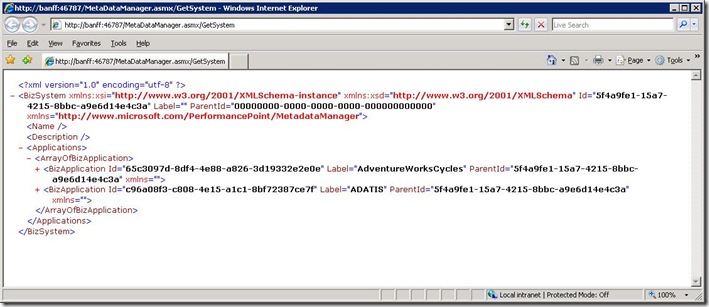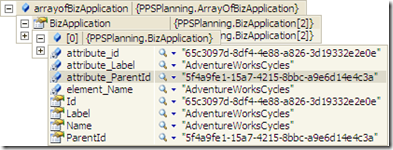Sorry for those who have been waiting for this, but here it finally is, Part 2 of using the planning web service. In Part 1 we looked at the Web services exposed by PerformancePoint Planning. We also looked at the difficulties of de-serializing the XML, into the the object that are generated from the WSDL. Today we will look into how to get the BizSystem information from the web service.
Firstly lets remind ourselves what we are looking to get from the web service.
As we can see form XML document we have a node called Applications which contains an ArrayOfBizApplications, which contains, in this case 2 BizApplications. In turn if we try and use the object created from the WSDL in code, we find that we have an object called BizSystem. Lets have a look at this object.
public partial class BizSystem : MetadataObjectBase {
private System.Data.DataSet applicationsField;
/// <remarks/>
public System.Data.DataSet Applications {
get {
return this.applicationsField;
}
set {
this.applicationsField = value;
}
}
}
public abstract partial class MetadataObjectBase {
private string nameField;
private string descriptionField;
private IdRef bizTypeIdRefField;
private System.Guid idField;
private string labelField;
private System.Guid parentIdField;
/// <remarks/>
public string Name {
get {
return this.nameField;
}
set {
this.nameField = value;
}
}
/// <remarks/>
public string Description {
get {
return this.descriptionField;
}
set {
this.descriptionField = value;
}
}
/// <remarks/>
public IdRef BizTypeIdRef {
get {
return this.bizTypeIdRefField;
}
set {
this.bizTypeIdRefField = value;
}
}
/// <remarks/>
[System.Xml.Serialization.XmlAttributeAttribute()]
public System.Guid Id {
get {
return this.idField;
}
set {
this.idField = value;
}
}
/// <remarks/>
[System.Xml.Serialization.XmlAttributeAttribute()]
public string Label {
get {
return this.labelField;
}
set {
this.labelField = value;
}
}
/// <remarks/>
[System.Xml.Serialization.XmlAttributeAttribute()]
public System.Guid ParentId {
get {
return this.parentIdField;
}
set {
this.parentIdField = value;
}
}
}
As we can see, the BizSystem contains one property, that is BizApplication, which is quite simply a DataSet. We can see from the XML that the Biz Application is unlikely to be able to be de-serialized into a dataset, and when we do try and access the dataset, we do not get any data tables contained within the dataset, nor any data from the XML.
private void LoadBizSystem()
{
MetaDataManager.MetadataManagerWebService ppsMDM = new MetaDataManager.MetadataManagerWebService();
System.Net.CredentialCache myCredentials = new System.Net.CredentialCache();
NetworkCredential netCred = new NetworkCredential("Administrator", "LetMeIn", "AServer");
myCredentials.Add(new Uri(ppsMDM.Url), "Basic", netCred);
ppsMDM.Credentials = myCredentials;
MetaDataManager.BizSystem bizSystem = ppsMDM.GetSystem(false);
DataSet ds = bizSystem.Applications;
DataTable dt = ds.Tables[0];
}
Although not necessarily the best way, what we can do is write a custom class that the XML can be de-serialized to, thus giving us the data from the Biz System. To begin with we need to create an object that will allow us to de-serialize the BizSystem into it, and therefore allowing us to access the properties of the BizSystem. From the XML we can work out that there are a number of attributes, and to keep this simple we will just prove that we can get the data from the BizSystem; these are:
- Name
- Id
- Label
- ParentId
Creating this object will allow us to retrieve the the attributes of a BizApplication. The object can be created as follows:
[XmlRoot("BizApplication")]
[Serializable]
public class BizApplication
{
private string element_Name;
private string attribute_id;
private string attribute_Label;
private string attribute_ParentId;
[XmlElement("Name")]
public string Name
{
get { return element_Name; }
set { element_Name = value; }
}
[XmlAttribute("Id")]
public string Id
{
get { return attribute_id; }
set { attribute_id = value; }
}
[XmlAttribute("Label")]
public string Label
{
get { return attribute_Label; }
set { attribute_Label = value; }
}
[XmlAttribute("ParentId")]
public string ParentId
{
get { return attribute_ParentId; }
set { attribute_ParentId = value; }
}
}
This object will allow us to gain access the the 4 attributes named above, however, the BizApplication are is contained in an array of applications, so we need to create another object that contains an array of BizApplications. Also in this object we can embed the de-serialization routine, and create a method that takes an XML Document of BizSystem, to de-serialize. So we need to get the XML returned from the web service, as opposed to the attempted de-serialized version. So we need to alter what the call to biz system returns. Now this is a bit of a hack, however I can assure you that it does work. We need to change the object that is returned from the web service, so if we go to the definition of Biz System, and alter the reference so it returns an XmlNode[].
[System.CodeDom.Compiler.GeneratedCodeAttribute("System.Xml", "2.0.50727.3031")]
[System.SerializableAttribute()]
[System.Diagnostics.DebuggerStepThroughAttribute()]
[System.ComponentModel.DesignerCategoryAttribute("code")]
[System.Xml.Serialization.XmlTypeAttribute(Namespace="https://www.microsoft.com/PerformancePoint/MetadataManager")]
public partial class BizSystem : MetadataObjectBase {
private System.Xml.XmlNode[] applicationsField;
/// <remarks/>
public System.Xml.XmlNode[] Applications
{
get {
return this.applicationsField;
}
set {
this.applicationsField = value;
}
}
}
So now we have the object returned as an XmlNode, so its time to write the ArrayOfBizApplications object, and the de-serialize method.
[Serializable]
[XmlRoot("ArrayOfBizApplication")]
public class ArrayOfBizApplication
{
private BizApplication[] element_BizApplicationList;
[XmlElement("BizApplication")]
public BizApplication[] BizApplication
{
get { return element_BizApplicationList; }
set { element_BizApplicationList = value; }
}
public static ArrayOfBizApplication LoadApplications(BizSystem bizSystem)
{
//Get the Applicaiotn list as an object.
Object bizApplication = null;
ArrayOfBizApplication arrayOfBizApplicaion = null;
try
{
bizApplication = bizSystem.Applications;
}
catch (Exception err)
{
//Log Exceltion here..
//Try and Cast it! (Untested)
bizApplication = (Object)bizSystem.Applications;
}
//We know this is an XML object - it has come back from the webservice
XmlNode[] xmlNodes = (XmlNode[])bizApplication;
StringBuilder sb = new StringBuilder();
sb.Append("<ArrayOfBizApplication>");
//We Only want an array of BizApplicaiotoins
foreach (XmlNode xmlNode in xmlNodes)
{
if (xmlNode.Name.ToLower() == "arrayofbizapplication")
{
sb.Append(xmlNode.InnerXml.ToString());
}
}
sb.Append("</ArrayOfBizApplication>");
XmlSerializer serializer;
System.IO.StringReader sr = new System.IO.StringReader(sb.ToString());
XmlTextReader xmlTReader = new XmlTextReader(sr);
try
{
serializer = new XmlSerializer(typeof(ArrayOfBizApplication));
arrayOfBizApplicaion = (ArrayOfBizApplication)serializer.Deserialize(xmlTReader);
}
catch (Exception err)
{
string test = err.Message;
throw err;
}
finally
{
//Close the reader.
xmlTReader.Close();
}
// return the list of BizApplication.
return arrayOfBizApplicaion;
}
}
We finally have some data from the Get System, we can browse our objects, which has some basic data within them.
Upon more investigation and examination of the XML that is returned you can easily extend these objects to return as much data as you require from Biz System. If you have any questions, or have had more success with the Planning Web service please contact me. For now, I hope to make more progress with the web service over the coming months.



Introduction to Data Wrangler in Microsoft Fabric
What is Data Wrangler? A key selling point of Microsoft Fabric is the Data Science
Jul
Autogen Power BI Model in Tabular Editor
In the realm of business intelligence, Power BI has emerged as a powerful tool for
Jul
Microsoft Healthcare Accelerator for Fabric
Microsoft released the Healthcare Data Solutions in Microsoft Fabric in Q1 2024. It was introduced
Jul
Unlock the Power of Colour: Make Your Power BI Reports Pop
Colour is a powerful visual tool that can enhance the appeal and readability of your
Jul
Python vs. PySpark: Navigating Data Analytics in Databricks – Part 2
Part 2: Exploring Advanced Functionalities in Databricks Welcome back to our Databricks journey! In this
May
GPT-4 with Vision vs Custom Vision in Anomaly Detection
Businesses today are generating data at an unprecedented rate. Automated processing of data is essential
May
Exploring DALL·E Capabilities
What is DALL·E? DALL·E is text-to-image generation system developed by OpenAI using deep learning methodologies.
May
Using Copilot Studio to Develop a HR Policy Bot
The next addition to Microsoft’s generative AI and large language model tools is Microsoft Copilot
Apr